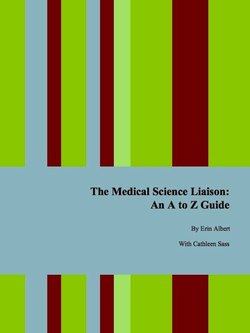The Medical Science Liaison: An A to Z Guide, Second Edition

Реклама. ООО «ЛитРес», ИНН: 7719571260.
Оглавление
Erin Ph.D. Albert. The Medical Science Liaison: An A to Z Guide, Second Edition
Introduction: The History of the MSL
The Past and Future of MSLs: Interview with Stan Bernard, MD, MBA
History
PART I: BECOMING A MSL. Chapter 1: What is a MSL?
The Challenges of a MSL
The Real World: An Interview with a Working MSL - Ernie Pitting, RPh, MS, PharmD candidate
Chapter 2: Activities, Salary, Job Satisfaction and Career Paths of the MSL
Benefits for the MSL: Interview with Chris Conley, CSAM
Chapter 3: Getting Hired
Part 1: Values Assessment
Skills and abilities specific to the MSL:
Part 2: Resume/CV
Part 3: The Cover Letter
Contacts/Networking Strategies
Getting Into the MSL Role: A Recruiter’s Perspective - Interview with Tony Beachler
PART II: PERFECTING THE ART OF LIAISING. Chapter 4: Starting off as a MSL
Miscellaneous for the New MSL
Erin’s List of Over 20 places to find Thought Leaders
Regulatory Compliance
Legal/Regulatory Issues for the MSL To Consider: Interview with Christopher R. Hall, Esq
The International MSL Perspective: Interview with Michael Hamann, PhD
Chapter 5: Customers’ Viewpoints
Interview with Chris Bojrab, MD
Interview with Ron Chervin, MD, MS
Interview with James A. Simon, MD, CCD, FACOG
Interview with Paul Keck, MD
Chapter 6: Research & Technology
Resources For the MSL: An Interview with LouAnn Fare, MS
Managing Medical Information: An Interview with Dr. Amy Peak
MSLs, Metrics and Technology
About Metrics: An Interview with Michael Taylor
Chapter 7: Work + Life = Balance?
Erin’s Wall of Fame
The MSL Father - Tim Hill, PharmD, MS
Working as a MSL/Mom: Interview with Carole Carter-Olkowski
Working Solo - It’s Really A Team Effort
PART III: POST MSL - WHAT’S NEXT? Chapter 8: Job Hopping
The MSL Moving Onward: Interview with Bryan Vaughn
Over 30 Things To Have Experienced By Your 5th Year as a MSL:
Chapter 9: Management of MSLs
Medical Science Liaison Outsourcing: Interview with Kyle Kennedy
Interview with a MSL Manager: Susan E. Malecha, PharmD, MBA
Chapter 10: The Afterlife
Other career alternatives for MSLs:
Academic Pharmacy After the MSL role: Interview with Scott Stolte, PharmD
Entrepreneurialism Post MSL: Interview with Jane Chin, PhD
Ten Transferable Skills From MSL to Entrepreneur:
Life After the MSL Role in Medical Education: Interview with Matt Lewis, MPA
Chapter 11: The Future of the MSL Role
The Clinical Trial Liaison: Interview with Brian Best
Future Of The MSL: Closing Interview with Dr. Stan Bernard
In Conclusion
Appendix A: Major Medical Associations/Meetings for Therapeutic Areas
Appendix B: Real World Career Paths to and Beyond the MSL
Appendix C: Acronyms & Abbreviations
Bibliography, References, and Resources
Acknowledgements
PART IV: SECOND EDITION NEW MATERIAL. Epilogue (Second Edition Bonus Material)
New Interviews: What is Beyond the MSL Role?
Anonymous
Charles Arena, MD Medical Director, Utah Clinical Trials, LLC
Tom Peddicord, PharmD, FCCP Account Group Director, Global Prairie
Updates Since the First Edition
Other Books By Dr. Erin Albert
Отрывок из книги
Many know that the origin of the Medical Science Liaison (MSL) came out of Upjohn. What is not largely known, however, is the drug that started the MSL movement: it was tolbutamide (Orinase®). According to the text, A Century of Caring: The Upjohn Story by Robert Carlisle, the first ever MSL program was initiated by marketing to establish rapport and provide educational awareness to doctors before they were able to write prescriptions, during medical school. In 1967, the program was started and seeded by sales professionals that had, “intense interest in science, [had] high social skills, and recognize[d] that they [were] no longer detailing products”.1
The MSLs began calling on medical schools and thus, a movement was born. Upjohn had been mostly unknown to medical students, but after just 6 years of the MSL program, “Upjohn was one of the best-known”1 companies to medical students. The entire onus of the MSL was to provide education in the form of monographs, access to internal researchers, and assistance for external educational programs. The program was conceptualized and developed a mission to provide appropriate use of oral diabetic drugs, which at the time was a novel approach to diabetes.1
.....
From the outset, MSMs were designed to be different from MSLs and other sales representatives. As doctors, MSMs could relate to and interact with key opinion leaders and other doctors as “peers”. They shared a comparable level of scientific training, experiences, and knowledge with their physician customers. This enabled MSMs to earn the respect and time of physicians. In fact, BMS marketers found that MSMs were spending dramatically more time with physicians than sales representatives.
The roles of MSMs also differed dramatically from those of MSLs. We trained MSMs to handle several novel tasks, such as the management of regional and local opinion leaders, including speaker training; identification and placement of Phase IIIB and IV clinical trials; facilitation of physician dinner meetings; spearheading the pre-launch of new products; and training of sales representatives on disease states and product information. Like a special military force, the roles of MSMs expanded over time as senior Bristol-Myers Squibb (“BMS”) executives recognized their extensive capabilities and impact.
.....